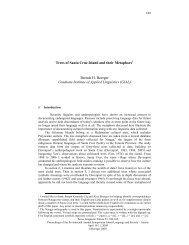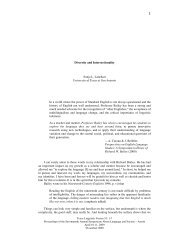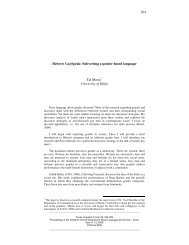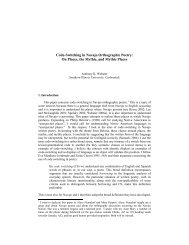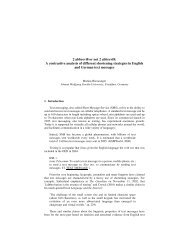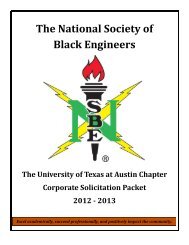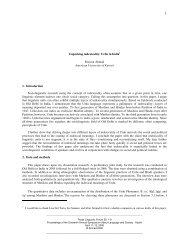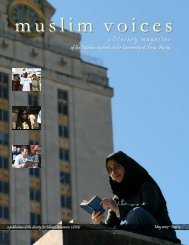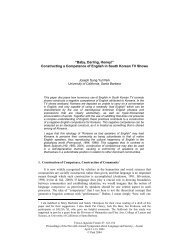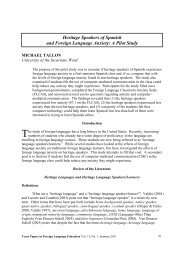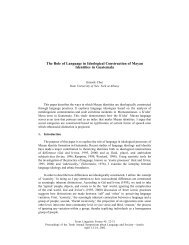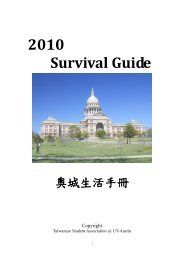The Impact of Bilingual Education on Indigenous Language and ...
The Impact of Bilingual Education on Indigenous Language and ...
The Impact of Bilingual Education on Indigenous Language and ...
You also want an ePaper? Increase the reach of your titles
YUMPU automatically turns print PDFs into web optimized ePapers that Google loves.
(4) School is important for us because we are surrounded by n<strong>on</strong>-indigenous people.<br />
So, the school is beneficial for us: it teaches writing <strong>and</strong> reading, <strong>and</strong> documents<br />
our language by keeping a written record <str<strong>on</strong>g>of</str<strong>on</strong>g> it. Before the school, we didn’t keep<br />
a record <str<strong>on</strong>g>of</str<strong>on</strong>g> the Tapirape language. We kept it <strong>on</strong>ly in our minds, in our memories.<br />
Nowadays, we are producing materials in our language. Also, school helps us<br />
dialogue with n<strong>on</strong>-indigenous people. We need to underst<strong>and</strong> them just as we<br />
need to write documents in Portuguese. (Ieremy’i Tapirape, 08.23.06, male<br />
Tapirape language teacher)<br />
Excerpts 2, 3 <strong>and</strong> 4 illustrate that knowledge about the n<strong>on</strong>-indigenous culture<br />
<strong>and</strong> language is c<strong>on</strong>sidered crucial in the fight for indigenous rights. Being surrounded by<br />
n<strong>on</strong>-indigenous people was a determining factor in founding the school. In additi<strong>on</strong>, as the<br />
interviewees argue, school created a new tool for Tapirape people – a way to record the<br />
language for future generati<strong>on</strong>s, as pointed out in (4). On <strong>on</strong>e h<strong>and</strong>, the interviewee claims<br />
that indigenous people have their own ways to save <strong>and</strong> protect their languages. <str<strong>on</strong>g>The</str<strong>on</strong>g>y do<br />
not need school to do it. On the other h<strong>and</strong>, the n<strong>on</strong>-indigenous presence forces indigenous<br />
people to search for extra ways to protect themselves. In this case, the extra way is the<br />
school which provides an additi<strong>on</strong>al mechanism to store the language <strong>and</strong> culture. Clearly<br />
the school is not an indigenous artifact. It was imposed by the violence <str<strong>on</strong>g>of</str<strong>on</strong>g> the c<strong>on</strong>tact with<br />
n<strong>on</strong>-indigenous people <strong>and</strong> it has been appropriated by the Tapirape people. This<br />
appropriati<strong>on</strong> within the Tapirape community entails giving meaning to <strong>and</strong> creating<br />
functi<strong>on</strong>s for that ‘foreign artifact’.<br />
<str<strong>on</strong>g>The</str<strong>on</strong>g> process <str<strong>on</strong>g>of</str<strong>on</strong>g> appropriati<strong>on</strong> <str<strong>on</strong>g>of</str<strong>on</strong>g> the school is related to indigenous aut<strong>on</strong>omy as<br />
well. As excerpt 5 below expresses, another goal <str<strong>on</strong>g>of</str<strong>on</strong>g> the school is to improve <strong>and</strong> promote<br />
indigenous aut<strong>on</strong>omy relative to n<strong>on</strong>-indigenous people:<br />
(5) <str<strong>on</strong>g>The</str<strong>on</strong>g> young people are being prepared by the school. In the future, we will not<br />
need n<strong>on</strong>-indigenous advisors anymore. We are improving our aut<strong>on</strong>omy. In this<br />
way school is a kind <str<strong>on</strong>g>of</str<strong>on</strong>g> tool. (Inamoreo Tapirape, 08.23.06, male geography<br />
teacher)<br />
Aut<strong>on</strong>omy - the right <str<strong>on</strong>g>of</str<strong>on</strong>g> a community to govern itself <strong>and</strong> to organize its own<br />
activities - can be fostered by the school, although the process may be a l<strong>on</strong>g <strong>on</strong>e. But<br />
because the school is a n<strong>on</strong>-indigenous inventi<strong>on</strong>, it must be shaped <strong>and</strong> directed by the<br />
indigenous people in order to ensure that it does indeed promote their aut<strong>on</strong>omy. <str<strong>on</strong>g>The</str<strong>on</strong>g><br />
Tapirape people have been shaping their school from the beginning; however, full<br />
aut<strong>on</strong>omy requires the training <str<strong>on</strong>g>of</str<strong>on</strong>g> young indigenous people to manage their school.<br />
3.2 Negative Aspects <str<strong>on</strong>g>of</str<strong>on</strong>g> the Tapirape <str<strong>on</strong>g>Bilingual</str<strong>on</strong>g> School<br />
Although Tapirape interviewees point out positive aspects <str<strong>on</strong>g>of</str<strong>on</strong>g> their school, most<br />
also recognize that the school has introduced pr<str<strong>on</strong>g>of</str<strong>on</strong>g>ound changes to their lives, <str<strong>on</strong>g>of</str<strong>on</strong>g> which<br />
some are unanticipated <strong>and</strong> unwelcome. Some interviewees evaluate these changes as<br />
negative aspects <str<strong>on</strong>g>of</str<strong>on</strong>g> the school. One example is the amount <str<strong>on</strong>g>of</str<strong>on</strong>g> time that the school occupies<br />
in the students’ daily lives, as described in excerpts 6 <strong>and</strong> 7:<br />
______________________________________________________________________<br />
Texas Linguistic Forum 52: 59-69<br />
Proceedings <str<strong>on</strong>g>of</str<strong>on</strong>g> the Sixteenth Annual Symposium About <strong>Language</strong> <strong>and</strong> Society – Austin<br />
April 11-13, 2008<br />
© Gorete Neto 2008<br />
___________________________________________________<br />
65



